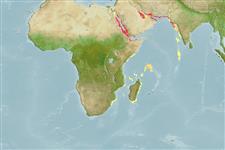>
Blenniiformes (Blennies) >
Tripterygiidae (Triplefin blennies) > Tripterygiinae
Etymology: Enneapterygius: Greek, ennea = nine times + Greek, pterygion = little fin (Ref. 45335).
Environment: milieu / climate zone / depth range / distribution range
Ekologi
laut dasar (demersal); kisaran kedalaman 2 - 22 m (Ref. 88983). Tropical
Western Indian Ocean: Red Sea.
Size / Weight / umur
Maturity: Lm ? range ? - ? cm
Max length : 2.5 cm SL jantan/; (Ref. 88983)
deskripsi pendek
Morfologi | Morfometrik
Duri punggung (Keseluruhan (total)): 15 - 17; duri punggung lunak (Keseluruhan (total)): 9-10; Duri dubur 1; Sirip dubur lunak: 16 - 18. Diagnosis: Dorsal fins III + XII-XIV + 9-10; anal fin I, 16-18 (usually 17-18 rays); pectoral fin 14-15: 3-4 + 5 + 6. LL, pored scales10-12, notched scales 21-22, starting at 2 scale rows below the end of the pored series; transverse scales 1/4; nape with scales, abdomen scaleless, single row of scales at base of pectoral fin. Body moderately slender, depth 6.0-6.5 in SL. Dentary pores 2 + 2 + 2 ; head 3.2-4.0 (usually 3.6) in SL; eye 2.8-2.6 (usually 2.5) in head length; orbital margin serrated; supratemporal sensory canal crescent-shaped; supraorbital cirrus elongated flap, about the size of pupil; orbital cirrus bilobed and moderately long, about half the diameter of pupil; mouth low, cleft nearly horizontal, lower lips with prominent labial folds; head profile rounded. First dorsal fin about equal in height to second; pelvic-fin rays not membrane bound or may be united for half the length of the shorter ray. Key features are: live color translucent red; caudal peduncle with small, intense black spot on upper part; first dorsal fin anterior brownish, posterior with spots white (Ref. 57774, 88983).
Adults inhabit bays and lagoons, on vertical walls of seaward reefs, coral and rocky areas, 2-22 m (Ref. 88983). Eggs are hemispherical and covered with numerous sticky threads that anchor them in the algae on the nesting sites (Ref. 240). Larvae are planktonic which occur primarily in shallow, nearshore waters (Ref. 94114).
Holleman, W. and S.V. Bogorodsky, 2012. A review of the blennioid fish family Tripterygiidae (Perciformes) in the Red Sea, with description of Enneapterygius qirmiz, and reinstatement of Enneapterygius altipinnis Clark, 1980. Zootaxa 3152:36-60. (Ref. 88983)
Status IUCN Red List (Ref. 130435)
ancaman kepada manusia
Harmless
penggunaan manusia
informasi lanjut
Umur / SaizPertumbuhanpanjang-beratpanjang-panjangukuran frekuensiMorfometrikMorfologiLarvaDinamika larvapemulihanKelimpahanBRUVS
AcuanBudidaya airprofil budidaya airStrainGenetikaElectrophoresesDiturunkanPenyakit-penyakitPengolahanNutrientsMass conversion
mitraGambarStamps, Coins Misc.Suara-suaraCiguateraKecepatanTipe renangArea insangOtolithsOtakPenglihatan / visi
Alat, peralatan
laporan khas
muat turun XML
Sumber internet
Estimates based on models
Preferred temperature (Ref.
123201): 26.9 - 29.3, mean 28.4 °C (based on 199 cells).
Phylogenetic diversity index (Ref.
82804): PD
50 = 0.5000 [Uniqueness, from 0.5 = low to 2.0 = high].
Bayesian length-weight: a=0.00794 (0.00346 - 0.01822), b=3.08 (2.88 - 3.28), in cm total length, based on LWR estimates for this (Sub)family-body shape (Ref.
93245).
Trophic level (Ref.
69278): 3.1 ±0.3 se; based on size and trophs of closest relatives
Daya lenting (Ref.
120179): Tinggi, Waktu penggandaan populasi minimum kurang dari 15 bulan (Preliminary K or Fecundity.).
Fishing Vulnerability (Ref.
59153): Low vulnerability (10 of 100).
